|
|
|
Sort Order |
|
|
|
Items / Page
|
|
|
|
|
|
|
| Srl | Item |
| 1 |
ID:
105119
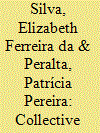

|
|
|
|
|
| Publication |
2011.
|
| Summary/Abstract |
This article aims to evaluate the potential use of collective marks and geographical indications as forms of protection for ownership and differentiation of handicraft production in Brazil, considered as intangible heritage. Although, the instruments of intellectual property are, a priori, suitable only for products with industrial application, the above instruments of IPR could be applied to traditional crafts as well. Geographical indications and collective marks are forms of intellectual property protection that are associated with reputation protection and market distinctiveness. Apparently, they could be effectively used to protect and appropriate benefits of economic exploitation in the case of craftsmanship as in Brazilian artisan products
|
|
|
|
|
|
|
|
|
|
|
|
|
|
|
|
| 2 |
ID:
170701
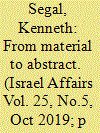

|
|
|
|
|
| Summary/Abstract |
Design anthropology has developed to become an influential sub-discipline occupied with both theoretical and applied knowledge targeted at designers’ real-life challenges. Bearing this in mind, in the last decade we have developed this attitude into a methodology centered around the identification and development of ‘cultural objects’ that can be implemented with insight and understanding within a conventional design process. This methodology isolates and magnifies the cultural aspects of objects and harnesses these to design new hybrid objects that reinterpret and translate cultural values and characteristics into a local context. This paper presents one of the various approaches dealing with the interpretation of philosophic, religious or socio-cultural principles of different cultures through an Israeli designer’s eyes. In this case the re-interpretation of Japanese, African or American cultures of wood and materializing various cultural traits led the students to an intricate and meaningful design process. From the results we recognized two points of significance: understanding that designing and researching through the isolation of a specific material (i.e., wood), the anthropological design process is crystalized and produces profound results that are culturally centered; the second was an insight into how young Israeli designers presented a unique and innovative approach towards contemporary Israeli design through the culture of wood.
|
|
|
|
|
|
|
|
|
|
|
|
|
|
|
|
| 3 |
ID:
178520


|
|
|
|
|
| Summary/Abstract |
The Geographical Indications of India Act requires a detailed description of ‘authorized users’ and ‘producers’ without concern for how these ‘producers’/ ‘authorized users’ are identified and what are the outcomes of such identification. Artisans identified as producers of GI registered ‘Cheriyal Painting’ of Telangana primarily belong to one genetically related family. Apart from members of the Danalakota household, GI also enumerates families of apprentices as ‘producers’. This article will highlight two things. First, it will demonstrate the way in which identification of ‘producers’/ ‘authorized users’ replicates not only the relational worlds within which producers exist but also the ‘obligations and moral imperatives’ embedded within those relations. Second, identifying oneself as a ‘producer’/ ‘authorized user’ requires distinguishing and individualizing one’s relatedness with the Danalakota family; promises of welfare by the state then become accessible only by becoming kin and distinguishing oneself as kin.
|
|
|
|
|
|
|
|
|
|
|
|
|
|
|
|
| 4 |
ID:
165930
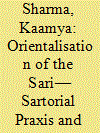

|
|
|
|
|
| Summary/Abstract |
This article analyses the homologies between colonial knowledge projects and post-colonial revival programmes through Indian textiles and dress. In the nineteenth century, the colonial bureaucracy treated Indian textiles as samples of ‘native’ artisanship, using them to police discourses of race, gender and citizenship. Concomitantly, the nationalist movement created a model of Indian womanhood that conscripted women to be both ‘traditional’ and ‘modern’, signified in the Nivi sari, linking this to emerging craft conservation movements. Post-Independence, elite women became the directors of craft revival by linking sartorial taste to ideal womanhood in a continuation of colonial discourse.
|
|
|
|
|
|
|
|
|
|
|
|
|
|
|
|
| 5 |
ID:
126039
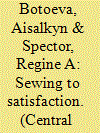

|
|
|
|
|
| Publication |
2013.
|
| Summary/Abstract |
This article focuses on the reassembling of apparel production in post-Soviet Kyrgyzstan. We contribute to this special issue on well-being in Central Asia by examining how individual craft-based apparel producers (a subset of producers in the apparel industry) describe the process through which they built upon their Soviet past and reoriented their professional trajectories in a new competitive market environment. These producers locate professional satisfaction in their ability to draw upon and creatively re-employ local knowledge and experience learned in Soviet institutions, ultimately - as they articulate and perceive - deriving pride and well-being from the process of selling highly regarded ethnically inspired apparel products both at home and abroad.
|
|
|
|
|
|
|
|
|
|
|
|
|
|
|
|
| 6 |
ID:
191790
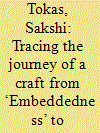

|
|
|
|
|
| Summary/Abstract |
Karl Polanyi’s theories on embeddedness and disembeddedness help unpack the transformation of exchange systems and emergence of markets in societies. This paper analyses a process of such transformation observed in the context of the hand block printing industry of Jaipur and its nearby areas. Through an ethnographic study of the craft, we observe the extent to which hand block printing has undergone heavy commodification and commercialisation while disembedding from the society. Over the years, aspects of hand block printing, such as design, labour and authenticity, have changed for the worse, which has further impacted the socio-cultural identity of this craft and crafts(wo)men engaging in it. Some underlying forces behind this are the commodification of labour and the commercialisation of the craft. While expanding on these, the paper also provides policy recommendations on the aspects of recognising artists and standardising labels in the industry.
|
|
|
|
|
|
|
|
|
|
|
|
|
|
|
|
| 7 |
ID:
165898
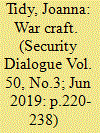

|
|
|
|
|
| Summary/Abstract |
This article makes the case for examining war from what Stephanie Bunn calls a ‘making point of view’. Makers and their material production of and for war have been neglected in our accounts of war, security and international relations. An attention to processes of making for war can reveal important things about how such processes are lived and undertaken at the level of the body. The article focuses on the particular phenomena of martial craft labour – the recreational making of ‘stuff’, including hats and pillowcases, by civilians for soldiers. To explore embodiment within this social site, an ethnographic method is outlined that enables the reading of objects as embodied texts, the observation of others in processes of making, and the undertaking of making by the researcher. Analysing embodied registers of aesthetic expression and the social values that attend such crafting for war reveals how this making is a space through which intimate embodied, emotional circulations undertake work for liberal-state and military-institutional logics and objectives, obscure violence, normalize war, and produce the military as an abstract social cause. Beyond the immediate empirical focus of this article, a much wider political entanglement of violence, embodiment and material production necessitates a concerted research agenda.
|
|
|
|
|
|
|
|
|
|
|
|
|
|
|
|
|
|
|
|
|